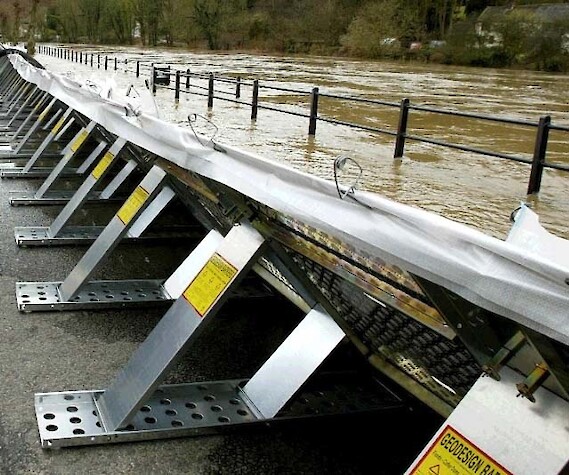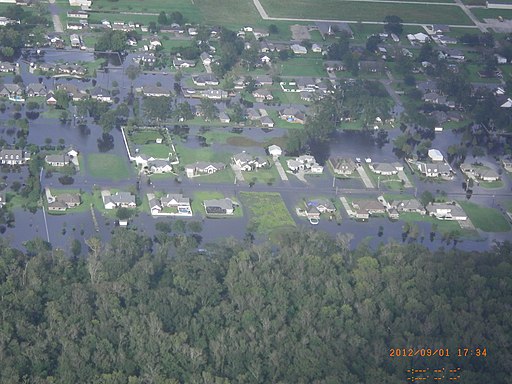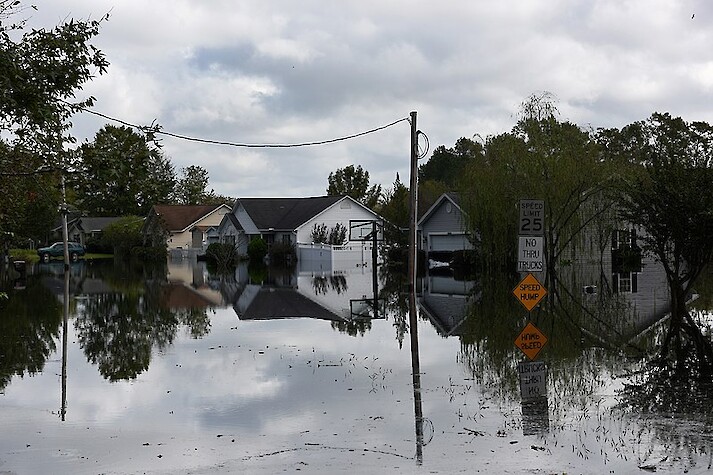Coastal Flooding and Environmental Justice
Imani Wilburn ·In our tenth week of class last Friday, April 9th, 2021, each student presented information on an environmental justice indicator they chose. While all of the indicators were beyond interesting and thought-provoking, none of the other indicators caught my attention like the coastal flooding indicator presented by fellow students Imani Black, Andrea Miralles-Barboza, and Chelsea Richardson. They discussed using data for nuisance flooding, flooding that places the public at an inconvenience, along with data that measures social vulnerability to accurately monitor this environmental justice indicator. But, many people are not even aware of this issue.
I currently live half a mile from the University of Maryland Eastern Shore’s campus. Just about every time it rains we get coastal flooding advisories. A few cars in the area have been totaled, but I have never thought much about this before I was introduced to this issue.

As most people know, a large percentage of people in the USA live in coastal communities. This means a large percentage of the population is regularly exposed to coastal flooding. When thinking about all of the impacted people, it is obvious that low-income communities and communities of color would be disproportionately affected by these events. Because of climate change and sea-level rise, coastal flooding is occurring more frequently and is expected to increase in frequency in the future.
According to an article published by the National Environment Education Foundation, coastal flooding places public infrastructure and human health at risk. For example, the author, Nick Bradford, mentions the possible impacts of these floods—including things such as frequent road closures, reduced stormwater drainage capacity, deterioration of infrastructure, and the introduction of saltwater into drinking water. The example also mentioned human health impacts such as people being exposed to pathogens or harmful chemicals. This problem is becoming increasingly serious as scientists expect the risks these communities face because of coastal flooding to almost triple by 2050.

In order to counter the impacts of coastal flooding, money is of course needed— something low-income communities and communities of color lack in their neighborhoods. This leads to those communities being disproportionately affected and places them at more of a risk than other, wealthier communities.

The National Oceanic and Atmospheric Administration (NOAA) has developed a coastal flood exposure mapping tool that can help communities understand the risks they face because of coastal flooding. This tool could really assist communities in educating themselves about their current risks and could even allow for comparisons of themselves to other communities in their area. Scientists are also developing infrastructure to help these communities as well as plans to increase resilience. Extra thought, of course, must be given to these low-income communities and communities of color if there is any hope of attempting to address this environmental justice issue.
References
Aridi, R. (2020, December 03). Affordable Housing Units Prone to Floods Could Triple by 2050. Smithsonian Magazine. Retrieved from https://www.smithsonianmag.com/smart-news/rising-tides-brought-climate-change-threaten-already-limited-affordable-housing-market-180976441/
Bradford, N. (n.d.). Increases in Coastal Flooding. National Environmental Education Foundation. Retrieved from https://www.neefusa.org/nature/land/increases-coastal-flooding#:~:text=Impacts%20of%20coastal%20flooding%20may,of%20saltwater%20to%20drinking%20water
Herreros-Cantis, P., Olivotto, V., Grabowski, Z. J., & McPhearson, T. (2020). Shifting landscapes of coastal flood risk: environmental (in) justice of urban change, sea level rise, and differential vulnerability in New York City. Urban Transformations, 2(1), 1-28. doi: https://doi.org/10.1186/s42854-020-00014-w
NOAA Office for Coastal Management. (n.d.). Coastal Flood Exposure Mapper. Retrieved from https://coast.noaa.gov/digitalcoast/tools/flood-exposure.html
About the author
Imani Wilburn

Imani Wilburn is a second-year master’s student at the University of Maryland Eastern Shore in their Marine Estuarine and Environmental Sciences program with a focus on ecological Foundations. Her work with her advisor Dr. Maurice Crawford involves quantifying the microplastics in the Maryland Coastal Bays, as well as attempting to develop a method to safely remove microplastics from water.
Next Post > Facilitating a Great Barrier Reef partnership workshop in Brisbane
Comments
-
Isabel Sullivan 5 years ago
Great choice of an indicator to spotlight! I agree that coastal flooding is a very apparent indicator of environmental injustices. We see wealthy communities that can afford to move or continue to update their homes while the low-income, minority communities do not have those options.
-
Taylor Gedeon 5 years ago
“ the possible impacts of these floods—including things such as frequent road closures, reduced stormwater drainage capacity, deterioration of infrastructure, and the introduction of saltwater into drinking water. The example also mentioned human health impacts such as people being exposed to pathogens or harmful chemicals”
Love how you highlighted these additional concerns and potential impacts. Crucial to realize the chain of events and negative impacts that one event can set off. Great blog!
-
Andrea M Miralles-Barboza 5 years ago
Imani I appreciate your personal views on this as a person who lives in a coastal flooding vulnerable area. Very powerful!
-
Chelsea Richardson 5 years ago
Thanks for highlighting the coastal flooding indicator! When doing research for this indicator I came across this article "Coastal flooding study finds trust-building, power-sharing key for environmental justice" by Portland State University and in it they discuss the importance of including the people affected by the flooding in the flood mitigation strategy process. I think it is important that we also consult the individuals that are impacted by not only coastal flooding, but for all of the other indicators that we are including in our report card.
Link to the Portland State University article: https://phys.org/news/2020-08-coastal-trust-building-power-sharing-key-environmental.html
-
Sarah 5 years ago
When I was living on UMES's campus, I also saw the flooding that was occurring in the area of Princess Anne, MD. I remember one flood in particular that canceled classes for the day due to flooding in buildings. It is a much powerful thing to observe the hardship that these communities face as opposed to other communities. Really powerful choice of a topic that needs more recognition!
-
Megan Munkacsy 5 years ago
Flooding is a now problem - hopefully more stories from the Eastern Shore like yours can continue to drive that home so resources can be provided equitably.
-
Amanda Rockler 5 years ago
Imani, great blog and I agree that coastal flooding is a terrific indicator to include in the report card. In case you are interested, DNR is rolling out something called mycoast - https://mycoast.org/md
Essentially it is a way for communities to track and share flood information to visualize the impacts of flood events; to enhance awareness among decision-makers and residents of Maryland and to encourage action to reduce flood risks. -
Ashley Silver 5 years ago
Flooding is a major issue on the eastern shore. I see it often just a few mile north of Princess Anne in Salisbury. Its a street in downtown Salisbury that has been blocked off for a while because it floods all the time and the city drags out fixing the problem.
-
Shakira 5 years ago
I agree with a lot of your personal views Imani. Living in the Princess Anne for years opened my eyes to issues coastal areas experience. The additional concerns mentioned are just as important as the coastal flooding. I know locals that buy water to do everything from watering plants, to drinking, to washing hair. I find it unfortunate that there are so many areas like this. Great job with bringing awareness to this indicator.
-
Olivia Wolford 5 years ago
The photos really helped complement the information and drive home how devastating these events are. I appreciate your perspective on this as someone who lives in a coastal flooding area and can be impacted by the issue. Great job!
-
Jehnae Linkins 5 years ago
This was very insightful especially incorporating your personal views and how your affected by coastal flooding. Flooding is a major issue, so much damage can be caused. The photos were very powerful and outlining your point.
-
Amber 5 years ago
Great job highlighting why this flooding is not just a "nuisance" but poses a serious risk to health and property. And of course those with the fewest resources, often people of color, will be unable to adapt or move to avoid the damage to their health and property. Hopefully legislation, funding, and working with those communities is in the future, as this issue will only worsen.
-
Faith Taylor 5 years ago
I like how you connected this to your own experience. I wonder how many people have been impacted by environmental injustices, but aren't classifying their concerns as "environmental justice issues".
-
Imani Black 5 years ago
Imani, when researching and learning more about this indicator I felt like personally experiencing this situation pushed me to want to dive into this topic even after this class is over. I love that you mentioned the NOAA mapping tool because I think it's a good resource. In my opinion, now we need to get that information out to those communities that face these issues and help them understand the environment around them so they can have a better opportunity to adapt in a better way.
-
Haoyu(Peter) Chen 5 years ago
I agree a lot with your views on floods, they are indeed an interesting perspective. The increase in precipitation is one of the important manifestations of climate change. The government should increase subsidies for vulnerable communities in such extreme weather. I do not agree with the attitude of some parties speak loudly just because of 'they are weaker', because inequality is not the cause of that.
-
Katrina Kelly 5 years ago
I appreciate and see what you're talking about here around the Eastern Shore. It is both beautiful and concerning the way Nature is taking over the built environment here. The point you make about lack of funds to fortify or retrofit infrastructure that is better equipped to handle the effects of climate change and other environmental shifts is a poignant one, as well. And, yet, with so many NGOs situated in and near the Eastern Shore, it is surprising that more funds are not somehow allocated to support the incredibly important Maryland natural resource that the Eastern Shore is. What's further is the amount of critical American history is also located here and is not protected or restored in the interest of historical and foundational value to the United States.
-
Nylah McClain 5 years ago
Being at UMES really does make you consider how much we can really do to protect people from coastal flooding. I see all of the drainage implemented, but even so the campus still has a huge flooding issue. I think that more implementation of green infrastructure practices can help coastal areas, but when I consider a place that is both rural and coastal I can see how the upfront cost of green infrastructure implementation may not be feasible when the threat is so immediate.

